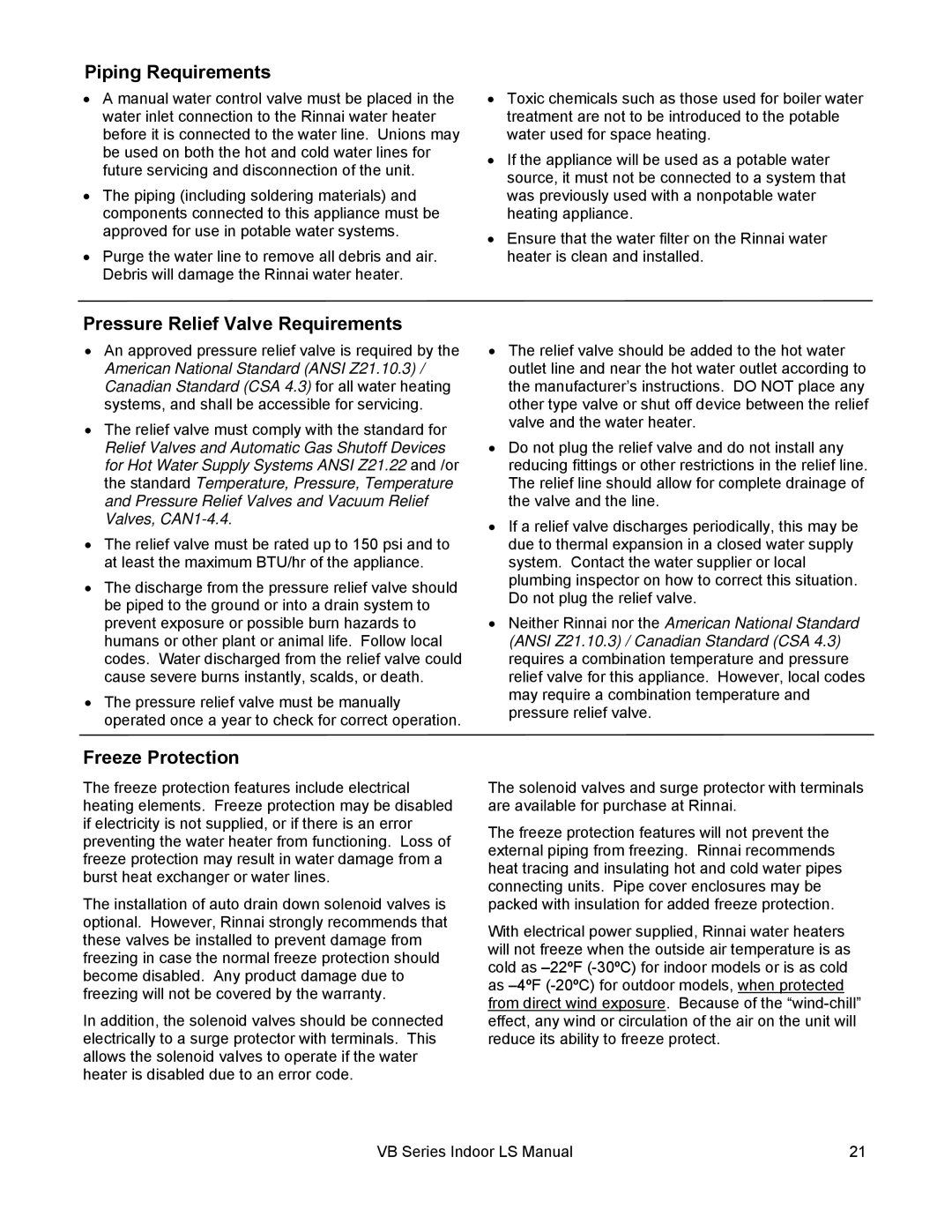
Piping Requirements
•A manual water control valve must be placed in the water inlet connection to the Rinnai water heater before it is connected to the water line. Unions may be used on both the hot and cold water lines for future servicing and disconnection of the unit.
•The piping (including soldering materials) and components connected to this appliance must be approved for use in potable water systems.
•Purge the water line to remove all debris and air. Debris will damage the Rinnai water heater.
Pressure Relief Valve Requirements
•An approved pressure relief valve is required by the American National Standard (ANSI Z21.10.3) / Canadian Standard (CSA 4.3) for all water heating systems, and shall be accessible for servicing.
•The relief valve must comply with the standard for Relief Valves and Automatic Gas Shutoff Devices for Hot Water Supply Systems ANSI Z21.22 and /or the standard Temperature, Pressure, Temperature and Pressure Relief Valves and Vacuum Relief Valves,
•The relief valve must be rated up to 150 psi and to at least the maximum BTU/hr of the appliance.
•The discharge from the pressure relief valve should be piped to the ground or into a drain system to prevent exposure or possible burn hazards to humans or other plant or animal life. Follow local codes. Water discharged from the relief valve could cause severe burns instantly, scalds, or death.
•The pressure relief valve must be manually operated once a year to check for correct operation.
•Toxic chemicals such as those used for boiler water treatment are not to be introduced to the potable water used for space heating.
•If the appliance will be used as a potable water source, it must not be connected to a system that was previously used with a nonpotable water heating appliance.
•Ensure that the water filter on the Rinnai water heater is clean and installed.
•The relief valve should be added to the hot water outlet line and near the hot water outlet according to the manufacturer’s instructions. DO NOT place any other type valve or shut off device between the relief valve and the water heater.
•Do not plug the relief valve and do not install any reducing fittings or other restrictions in the relief line. The relief line should allow for complete drainage of the valve and the line.
•If a relief valve discharges periodically, this may be due to thermal expansion in a closed water supply system. Contact the water supplier or local plumbing inspector on how to correct this situation. Do not plug the relief valve.
•Neither Rinnai nor the American National Standard (ANSI Z21.10.3) / Canadian Standard (CSA 4.3) requires a combination temperature and pressure relief valve for this appliance. However, local codes may require a combination temperature and pressure relief valve.
Freeze Protection
The freeze protection features include electrical heating elements. Freeze protection may be disabled if electricity is not supplied, or if there is an error preventing the water heater from functioning. Loss of freeze protection may result in water damage from a burst heat exchanger or water lines.
The installation of auto drain down solenoid valves is optional. However, Rinnai strongly recommends that these valves be installed to prevent damage from freezing in case the normal freeze protection should become disabled. Any product damage due to freezing will not be covered by the warranty.
In addition, the solenoid valves should be connected electrically to a surge protector with terminals. This allows the solenoid valves to operate if the water heater is disabled due to an error code.
The solenoid valves and surge protector with terminals are available for purchase at Rinnai.
The freeze protection features will not prevent the external piping from freezing. Rinnai recommends heat tracing and insulating hot and cold water pipes connecting units. Pipe cover enclosures may be packed with insulation for added freeze protection.
With electrical power supplied, Rinnai water heaters will not freeze when the outside air temperature is as cold as
VB Series Indoor LS Manual | 21 |
